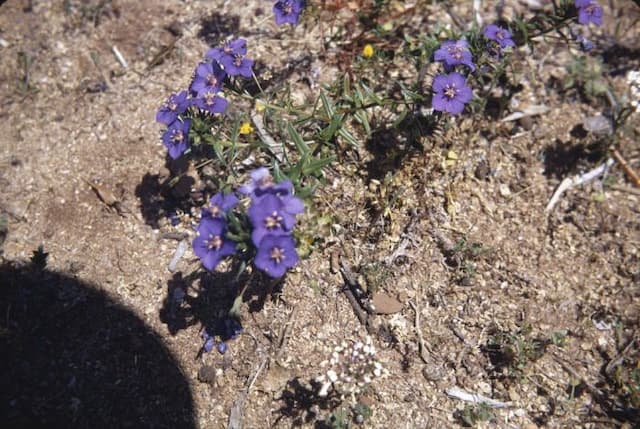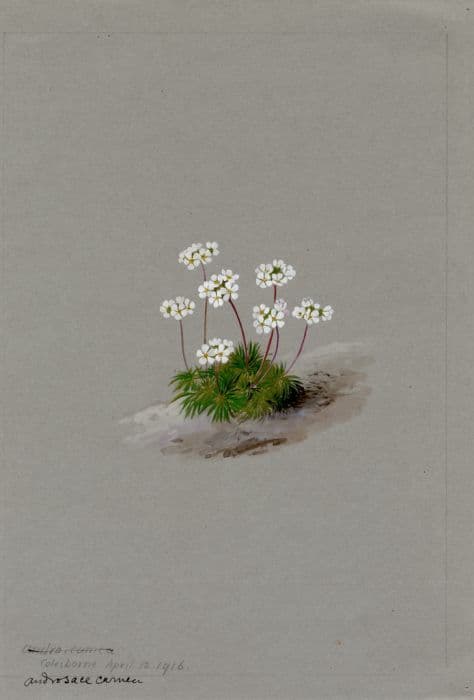Auricula Primula auricula 'Lee Paul' (Au/a)

ABOUT
Primula auricula 'Lee Paul', commonly known as auricula, is a distinctive and attractive plant. Displaying a unique rosette of leaves, the plant is characterized by its lush green foliage which provides a delightful backdrop for its flowers. The leaves are often thick and flesh-like, with a slightly powdery or waxy coating that can give them a subtle sheen. The flowers of the auricula are particularly striking and are a major draw for gardeners. They come in a range of colors, including shades of yellow, red, pink, purple, and almost black. The 'Lee Paul' variety showcases an intricately patterned bloom, typically with a rich, contrasting color at the center, which is often referred to as the "eye." This central zone might be a deeper or lighter hue than the rest of the petals, creating a vivid focal point. Around the eye, there can be another distinct color band or a series of concentric rings that add to the complexity of the flower's appearance. The petals are rounded and may be smooth or slightly ruffled, and they are arranged in concentric circles to form a full, almost flat flower face that resembles a pinwheel. The blooms are held aloft on sturdy stems that rise above the foliage, each stem carrying one or several flowers which form a cluster at the top. This arrangement makes the blossoms stand out and provides a pleasing contrast in both color and form to the plant's leaves. Overall, the auricula 'Lee Paul' is cherished for its ornamental beauty and the intricate design of its blooms, making it a favorite among garden enthusiasts and a decorative choice for outdoor spaces.
About this plant
 Names
NamesFamily
Primulaceae.
Synonyms
Bear's Ear, Mountain Cowslip, Auricula, Bear's Ear Primrose.
Common names
Primula auricula 'Lee Paul'.
 Toxicity
ToxicityTo humans
The plant in question is commonly known as Auricula. Auriculas are not widely recognized as being poisonous to humans. However, if consumed in large amounts, they might cause mild stomach upset or skin irritation in sensitive individuals due to the presence of saponins and other compounds. Ingesting this plant is unlikely to result in serious poisoning, but it is generally advised to not consume any part of ornamental plants due to potential adverse effects.
To pets
Auricula, while not considered highly toxic to pets, can cause mild gastrointestinal distress if ingested, such as vomiting or diarrhea. It is not known to be fatal or to cause serious illness in pets, but as with any non-food plant, ingestion should be avoided to prevent any potential discomfort to your animal. If you suspect your pet has consumed a significant amount of Auricula, it is wise to consult with a veterinarian.
 Characteristics
CharacteristicsLife cycle
Perennials
Foliage type
Evergreen
Color of leaves
Green
Flower color
Yellow
Height
0.5 feet (15 cm)
Spread
0.5 feet (15 cm)
Plant type
Herb
Hardiness zones
5
Native area
Europe
Benefits
 General Benefits
General Benefits- Aesthetic Appeal: The Primula auricula 'Lee Paul' adds vibrant color and beauty to gardens and landscapes with its unique and striking flowers.
- Easy to Grow: This particular variety of Primula is known for its ease of cultivation, making it suitable for gardeners of all skill levels.
- Long Flowering Period: It has a lengthy blooming time, providing colorful displays in the garden for an extended period in spring.
- Attracts Pollinators: The plant attracts bees and butterflies, which are beneficial for pollinating other plants in the garden.
- Versatility: It can be planted in a variety of settings, including borders, rockeries, and containers, offering flexibility in garden design.
- Heritage and History: As a cultivar with a long history in horticulture, it carries a legacy and charm appreciated by plant enthusiasts.
 Medical Properties
Medical PropertiesThis plant is not used for medical purposes.
 Air-purifying Qualities
Air-purifying QualitiesThis plant is not specifically known for air purifying qualities.
 Other Uses
Other Uses- Photography subjects: The striking colors and patterns of Auricula flowers can be used as stunning subjects for botanical photography, allowing photographers to capture their unique beauty.
- Artistic inspiration: Artists may draw inspiration from the vivid hues and unique shape of the Auricula for paintings, illustrations, or textile designs.
- Culinary decoration: Although not commonly consumed, the petals of Auriculas can be used as a decorative element for high-end culinary dishes, adding a splash of color and elegance.
- Educational tool: Auriculas can be used in schools or educational programs to teach students about plant biology, hybridization, and the diversity of the plant kingdom.
- Collectors’ item: Some horticulturists and gardeners collect various cultivars of Auriculas, including 'Lee Paul', for their unique traits and the challenge of cultivation.
- Theatre and film: These flowers can be used in stage productions or film sets as part of the scenery to create a visually impressive garden setting.
- Horticultural shows: Auriculas like 'Lee Paul' are often featured in flower shows and horticultural competitions for their striking appearance and diverse colors.
- Garden biodiversity: Planting Auriculas can contribute to garden biodiversity, attracting pollinators such as bees and butterflies that are enticed by their bright colors.
- Stress relief: Tending to Auriculas, as with other plants, can offer a form of stress relief and therapeutic horticulture for individuals seeking tranquility and a connection with nature.
- Botanical research: Auriculas can be subjects of botanical research, providing insights into plant genetics, adaptation, and hybridization techniques.
Interesting Facts
 Feng Shui
Feng ShuiThe Auricula, or Bear's ear, is not used in Feng Shui practice.
 Zodiac Sign Compitability
Zodiac Sign CompitabilityThe Auricula is not used in astrology practice.
 Plant Symbolism
Plant Symbolism- Uniqueness: The Primula auricula 'Lee Paul' is known for its unique and striking appearance, often symbolizing the value of being distinct and special in one's own way.
- Precision: As a cultivar selected for particular traits, it represents the idea of precision and attention to detail.
- Courage: The robust nature of Primula auricula, able to grow in rocky alpine regions, is often associated with bravery and resilience in the face of adversity.
- Patience: This plant takes time to establish and thrive, which can be symbolic of patience and the rewards of waiting for something truly beautiful to flourish.
 Water
WaterThe Bear's Ear should be watered moderately, ensuring the soil is kept moist but not soggy. During the growing season, water the plant thoroughly once a week with about 8-16 ounces depending on the size of the pot and the environmental conditions. Allow the top inch of soil to dry out before watering again to prevent root rot. In winter, reduce watering to every other week, ensuring the plant does not dry out completely.
 Light
LightThe Bear's Ear prefers bright, indirect light to thrive. A north or east-facing window is an excellent spot, offering the plant the gentle morning light or soft afternoon light without the direct harsh sun of midday. Avoid placing the Bear's Ear in full, direct sunlight as this can scorch the leaves and compromise the plant's health.
 Temperature
TemperatureBear's Ear does well in a temperature range of 50-75 degrees Fahrenheit. Ideally, the plant should be kept in a cool environment, as it thrives in cooler conditions and may suffer if temperatures rise consistently above 75 degrees Fahrenheit. While Bear's Ear can survive brief dips to as low as 40 degrees Fahrenheit, it should not be exposed to freezing temperatures.
 Pruning
PruningPruning the Bear's Ear encourages healthy growth and is best done in the spring after flowering has ceased. Deadheading spent blooms and removing any dead or yellowing leaves help to maintain the plant's vigor and appearance. Prune lightly to shape the plant if desired, doing so every year or as needed to control its size and encourage fresh growth.
 Cleaning
CleaningAs needed
 Soil
SoilAuricula primroses, including the 'Lee Paul' variety, prefer well-draining, moisture-retentive soil with added humus or leaf mold. A soil mix of one part loam, one part peat or compost, and one part perlite or grit is ideal. The soil pH should be slightly acidic to neutral, ranging from 6.0 to 7.0.
 Repotting
RepottingAuricula primroses should be repotted every one to two years, usually after flowering. Select a pot only slightly larger than the previous one, as these plants do not require excessively spacious containers.
 Humidity & Misting
Humidity & MistingAuricula primroses thrive in moderate humidity levels, ideally between 50% and 60%. They can tolerate lower humidity, but it's important to maintain a stable environment to prevent stress.
 Suitable locations
Suitable locationsIndoor
Place in bright, indirect light; keep soil moist but not soggy.
Outdoor
Partial shade; shelter from wind and intense midday sun.
Hardiness zone
4-8 USDA
 Life cycle
Life cyclePrimula auricula 'Lee Paul', commonly known as Bear's Ear, typically starts its life cycle when seeds are sown in late winter to early spring, subsequently germinating in a cool environment with indirect sunlight. Following germination, seedlings develop into rosettes with distinct, fleshy, sometimes farinose leaves. As the plant matures, flower stalks emerge from the center of the rosette in mid to late spring, displaying a range of colors from yellows to reds and purples, often with intricate patterns. After pollination, often by insects, the plant sets seed which can be collected when the seedpods have dried on the plant. Throughout summer and into fall, the rosettes continue to grow, storing energy for the next flowering season. Bear's Ear is perennial and enters a dormancy phase in winter, with the cycle repeating the following spring.
 Propogation
PropogationPropogation time
Spring-Early Summer
The Primula auricula 'Lee Paul', commonly known as Auricula Primrose, is typically propagated by division, which is the most popular method. This process involves carefully splitting the plant into smaller sections, each with its own set of leaves and roots. The best time to divide Auricula Primrose plants is in late summer or early fall, after the blooming period has ended but while the weather is still warm enough to allow the divisions to establish. To propagate by division, gently lift the entire plant from the soil and tease apart the clumps into smaller divisions, ensuring that each piece has healthy roots attached. These divisions should then be replanted at the same depth they were growing previously and watered in well. Remarkably, Auricula Primrose can recover quickly from division, often flourishing in the following growing season and producing its characteristic vibrant blooms.









